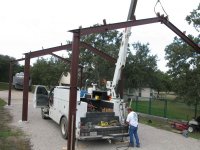Really? That's what I thought before I got mine. I've had mine in the mountains and you know how heavy I am. I have never felt like it was struggling up 7% grades. I will turn 36K on the truck in less than a year so that would be a lot of extra revolutions.
Now a functional exhaust brake would be nice. I wonder if they are going to make some improvements to keep up with the competion?
I don't find the highway hills an issue at all. It is that short choppy - what I call roller coaster hills. 2 lane, 35-45 speed limits, 100-300 foot up and down elevation changes in relatively short distances.
On some of the North east Pennsylvania roads I have gotten into the habit of using 4 wheel low. Truck doesn't work as hard and hte lack of a real exhaust brake is minimized.
4.30 is too much, so I figure a split between the two would be good. As for mileage, one of our members here pulling a Landmark, who lives in PA, had a 2011 350 DRW and just before Goshen traded it for a 2013 450. His towing mileage increased with the new truck.
My understanding is they are going to single turbo, larger but forgot size, that will have better turbo braking.
The 6.7 has always been a single turbo, but it has a two stage impeller and housing. Although is "acts" like a twin turbo it really is a one intake, one discharge unit.
One of the key features besides this new "sequential turbo" design was nesting the exhaust ports between the cylinder heads and mounting the intake manifold to the traditional exhaust port side of the engine.
2015 2nd generation 6.7:
GT37 turbo. The GT37 features a single, larger 88-millimeter compressor wheel that replaces the GT32’s dual-sided compressor design. The compressor forces air into the engine’s cylinders to improve performance—especially at high altitude where the air is thinner than at sea level. The turbine size is increased to 72.5 millimeters from 64 millimeters, so exhaust gases have a larger surface area to spin the turbo, providing extra power.
The wastegate and the wastegate controls are eliminated, because the turbo operates at lower peak pressures than the GT32.
The original designers of the current Power Stroke V8 diesel forecasted needs for higher output. This facilitated the larger turbocharger, increasing airflow and creating more power. We’ve dramatically improved performance while reducing overall engine complexity by focusing on the turbo system
—David Ives, Power Stroke technical specialist
A further benefit of the larger turbo is improved engine exhaust braking, manually controlled by a push-button switch on the dashboard. Extra braking power helps reduce wear and tear on wheel brakes and requires less manual brake application from the driver, especially on downhill grades.
Fuel system improvements. Turbo changes drove improvements to the fuel delivery system, specifically a new high-pressure fuel pump and fuel injectors. The pump’s cam stroke is increased to deliver more fuel when desired for increased power. All-new injector tips better atomize the fuel, resulting in improved combustion that enables lower noise, vibration and harshness. Other benefits include cleaner emissions and a reduction in the buildup of fuel deposits on the valves over time.
That turbo braking will be a welcome addition seeing how it is currently almost nonexistent.
And no doubt that last paragraph has a lot to do with the Achilles Heel of a fuel delivery system the Gen 1 engines have.
I suspect there will be many willing to trade up if they can manage it.
The real guess will be the specs, which I presume wlll be released shortly before launch.
425/850 anyone?

